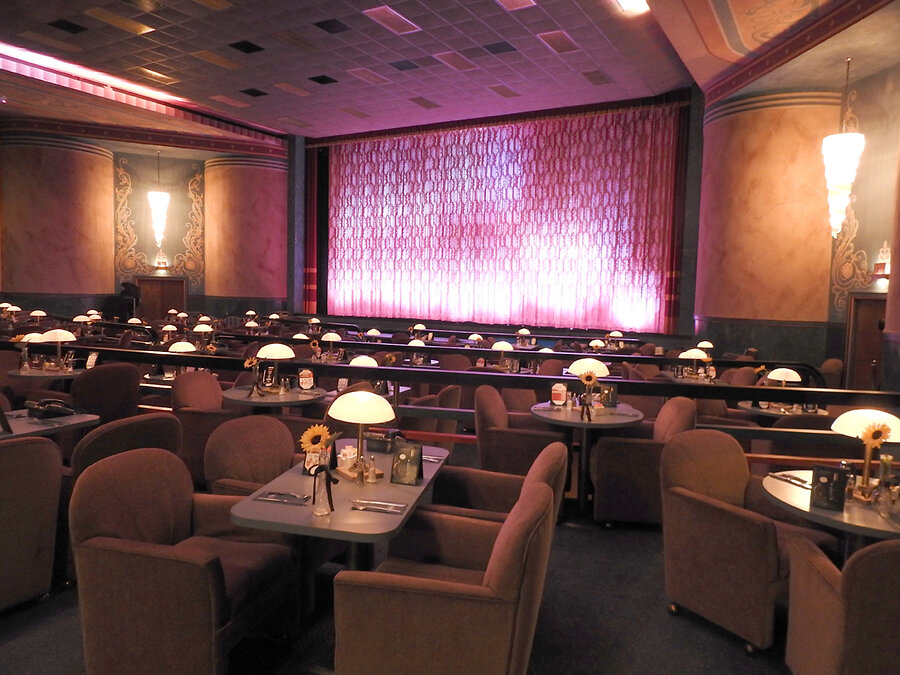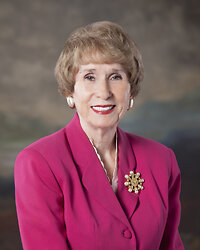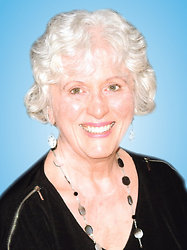THE COMMODORE THEATRE
A history of Virginia's most unique movie venue

The Commodore's dining tables, topped with Art Deco lamps and phones connected to its kitchen, are evocative of those found in a nightclub during the 1940s.
Portsmouth native William S. "Bunkie" Wilder built the Commodore Theatre in 1945 as the flagship theatre of his local chain of movie theatres. The theatre was designed by John J. Zink (1886-1952), a Baltimore architect who designed numerous famous theatres on the east coast. The auditorium, which measures 85 feet wide and 90 feet deep, is still the perfect size and shape for presenting today's newest films. The extraordinary design also prevents balcony patrons and main floor patrons from being visible to each other, allowing each to view the screen without distraction. Named for Commodore James Barron, a nineteenth-century naval officer buried in the church cemetery next door, the theatre has a nautical motif used in decorative detailing throughout the building.
The Commodore operated as a movie house until 1975 when, due to a national trend of declining downtown traffic, it closed. It remained closed for 12 years until it was purchased by Norfolk native Fred Schoenfeld, who began the restoration and revitalization process. Schoenfeld's vision was to restore the beautiful old theatre yet change the concept to combine first-run movies with full-service dining, the first such historic theatre in the country. The theatre's original 1,000-seat capacity was reduced to 190 table seats on the dining floor and, in the balcony, 318 traditional theatre seats served by a concession stand and restrooms.
Artwork in the auditorium and lobby areas was painstakingly restored by artists from Wall Illusions in Norfolk, with the principal artist being James Nelson Johnson of Virginia Beach. The original scenes on the 20-by-40-foot murals and the ceilings were repainted and enhanced. New chandeliers, made of Italian leaded crystal and each weighing over 300 pounds, replaced the old fluorescent chandeliers. In the two alcoves on each side of the inner lobby, the artists recreated scenes of the original theatre interior before the restoration work.
The theatre's kitchen is in the space once occupied by the manager's old office and the men's smoking lounge. The women's smoking lounge was restored with new wall coverings, chandelier, and furniture; the payphone in the lounge is of early 1940's vintage. Marble bases on the table lamps were cut from marble removed from the main restrooms during construction. Table lamps and the chandelier in the women's lounge were custom-made for the Commodore by Morrison Studios located in Northern California. The stage curtains reflect the traditional movie presentation technique of having both a house curtain as well as a screen curtain. The house curtain was specially created for the Commodore in 1989 by Greenville Stage Equipment Company in Greenville, South Carolina, while the screen curtain is the Commodore's' original curtain from 1945.

The marquee in front of the theatre was restored with stainless steel panels and plating, with over 900 new sockets and bulbs and new neon tubing. The original construction of the marquee is impressive, with a six-inch-thick concrete roof held up by 30-inch "I" beams projecting 20 feet from the front of the theatre. The estimated weight is over 20 tons.
Excellence in sound and image exhibition has been Schoenfeld's objective from the outset. As an electrical engineer and holder of a master electrician's license, with a specialty in theatre sound and projection systems, he designed the Commodore's sound system with the help of George Lucas' THX group at LucasFilm in Marin County, California. Up until April 2012, the Commodore showed 35 mm film. At that time, the theatre converted to a fully digital system. All movies are now delivered on a computer hard drive. Barco Systems in Belgium made the theatre's projectors, while its server and audio processor was created by Dolby Labs in California. Nine large JBL speakers are mounted in the sound wall behind the 41-by-21-foot screen, and 22 surround-sound speakers are throughout the auditorium, including six behind the theatre's murals. The sound system has three screen channels, four discrete auditorium channels, and four large sub-woofers behind the screen, also known as 7.1 audio. To ensure superb quality film exhibition and sound, the Commodore has had THX (LucasFilm) certification since its opening in 1990.
Schoenfeld's work was honored in 1995 when the theatre earned designation as a Virginia Historic Landmark and was listed on the National Register of Historic Places. The Commodore is recognized nationally and internationally as a unique movie-going and dining experience.
The theatre is dedicated to the memory of Norman Powell and Kenneth Andrews, who trained and nurtured Schoenfeld, as a youngster, in the movie business and worked long and hard to help him realize his dream for the Commodore.
The theatre is dedicated to the memory of Norman Powell and Kenneth Andrews, who trained and nurtured Schoenfeld, as a youngster, in the movie business and worked long and hard to help him realize his dream for the Commodore.
Being a family business, Schoenfeld's three children-Victoria, Ben, and Abby-grew to adulthood working in the theatre with their father.
Guests always receive a warm welcome in the hope that they will enjoy the unique atmosphere of the historic Commodore Theatre.
Commodore Theatre
421 High Street
Portsmouth, VA 23704
757-393-6962
http://www.commodoretheatre.com
CURRENT COLUMNS
Children First 
Dandelion Timeby Becky AdamsPublisher’s Point 
Time To Moveby Jean Loxley-BarnardOn The Front Porch With You 
Memories of Homeby Rob LauerRelationships 
When Your Security Blanket is in the Dryerby Dr. Bill Austin

